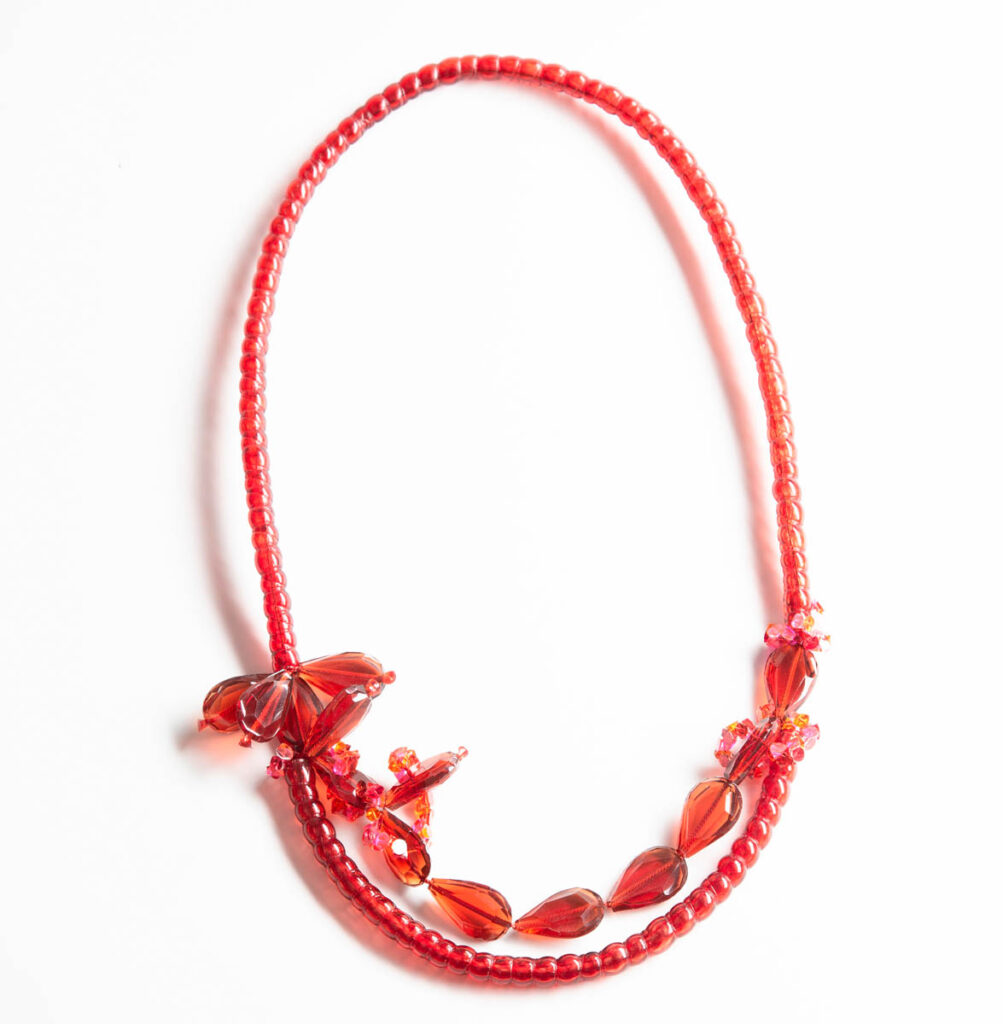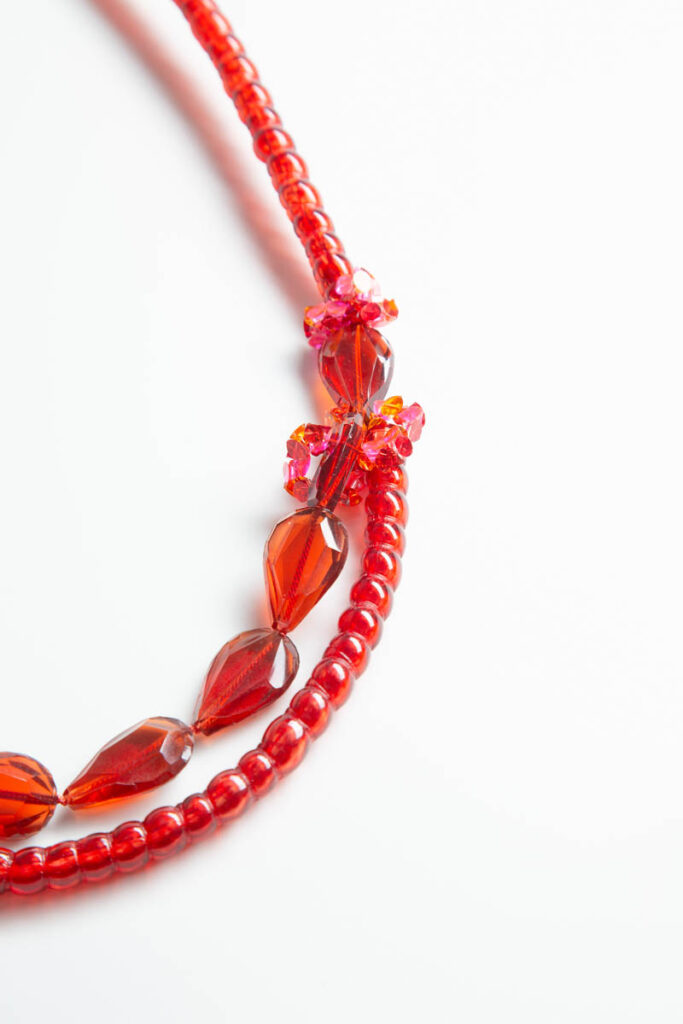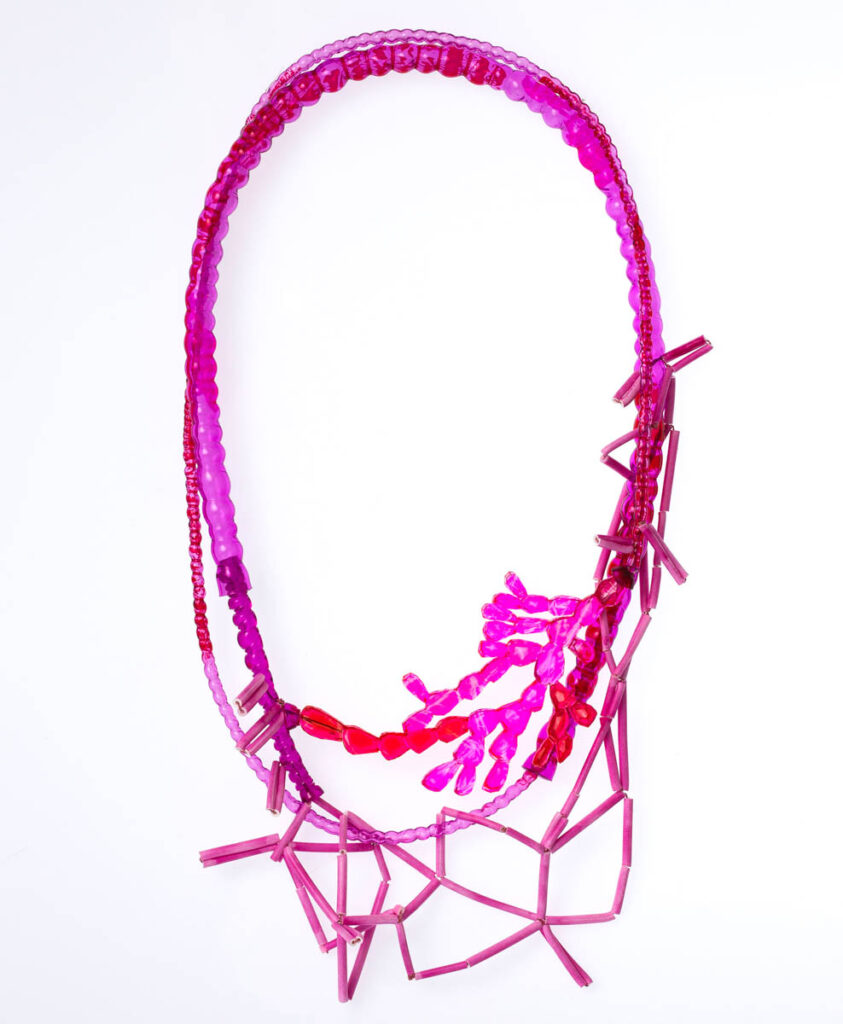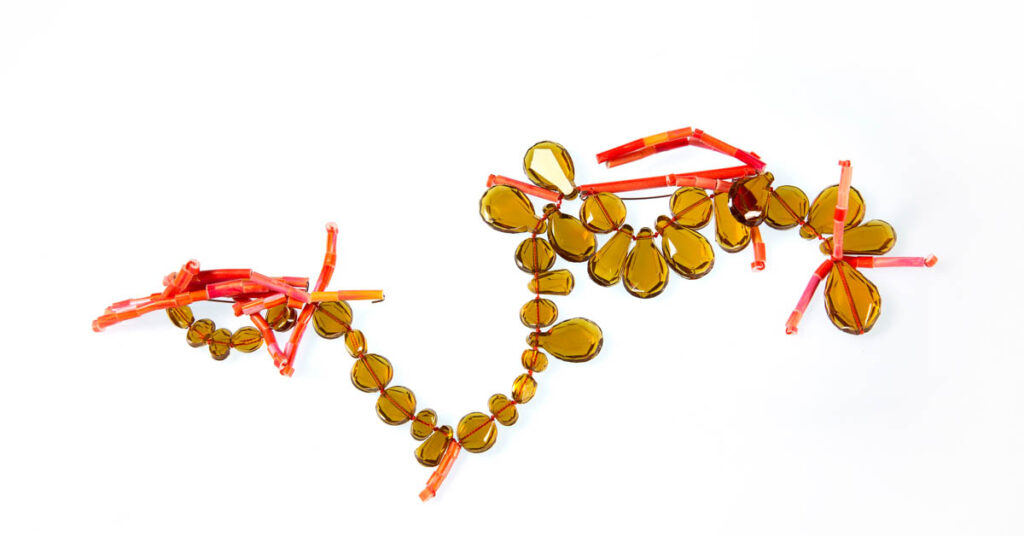
Kath Inglis, Sea Grapes + Coraline Epiphytes Brooch, 2019, Variable – approx. 210mmx 100mmx 25mm, Hand cut, carved and heat fused layers of PVC coloured with dye. Lollypop sticks, ink, silk thread and stainless steel wire., Photographer: Craig Arnold
Kath Inglis writes about the concept “of uncertain value”, reflected in the epiphyte jewels carved out of PVC.
Since 2001, making wearable pieces from flexible Polyvinyl Chloride sheet (PVC) has been central to my jewellery practice. My mission is to transform this prosaic material into the precious through simple handworked processes such as dyeing, cutting, carving and heat-fusing layers.
Plastic is routinely regarded with little value, sometimes designed to be a single-use item, passing from our hands to a sentence of waste for thousands of years. This use of plastic has significant impacts on the environment, in particular, marine environments.
In 2019 I was awarded a Guildhouse Collections Project with the Adelaide Botanic Gardens as I wanted to connect my work to this issue by investigating the marine algae (seaweed) collection at the State Herbarium of South Australia through a lens of values.
Early in my investigations, my curiosity was attracted to epiphytes. Epiphytes are plants or algae that grow upon another. Not to be confused with parasitic or symbiotic relationships, one plant is simply hosting another, or in some cases with marine algae, many. These complex arrangements of biodiversity are an extraordinary demonstration of mutually respectful and sustainable relationships.
Observing the dried specimens of marine algae through a microscope, I frequently referenced their intriguing surfaces to the plastic materials that I was familiar with, including cling wrap, lollypop sticks, cellophane, fishing line and mesh bags for oranges. Many of these plastic items are often discarded after a single use. I decided to weave these new materials into my studio exploration.
The results of this 6-month project were presented as a solo exhibition in the Museum of Economic Botany. The title was developed from my investigations into a textbook written by the late Professor Bryan Womersley describing various species of marine algae. It was here I found an entry for a specimen of marine algae without a name, listed as “species of uncertain location”. To allocate the taxonomy of a species, between 30-40 specimens need to be collected so it can be clearly defined. Only several specimens of this species were collected so far, leaving it hanging in a space of uncertainty. This was a neutral use of the term, but uncertainties can be viewed with mixed feelings. Sometimes unnerving, provoking fear and intimidation, uncertainties also allow room to play with ideas, the flexibility and fluidity of things to move and change through circumstances of events or time, so I tied this to my exhibition of uncertain value.
Little did I know that the following year of 2020 would be full of uncertainties. On the 11th of March, the Covid 19 pandemic was announced and I was also diagnosed with breast cancer (I’m in remission now). Two days later I arrived in Melbourne for the opening of uncertain value at Studio Ingot when crazy panic buying set in and borders were starting to close.
The pandemic has reinvigorated our embrace of single-use plastics to stop the spread of infection. Mountains of face masks, plastic gloves and testing kits are now added to this burden of single-use plastic waste. There is an entanglement of values.
Throughout 2021 and 2022, I have continued to grow from my investigations from the Collections Project at the State Herbarium, uncovering rich entanglements of values between the living and non-living, recognising positive natural relationships, creative hope and seeking material justice.
These pieces have all come together for my solo exhibition Entanglements at Bilk Gallery from 21st November until 24th December 2022.
- Kath Inglis, Red Epiphyte Neckpiece, 2022, 300mm x 180mm x 20mm, PVC tube – dyed, cellophane printing and heat formed. PVC sheet – dyed, cellophane printing, cut, carved and heat fused layers. Silk thread + stainless steel wire., Photographer: Craig Arnold
- Kath Inglis, Red Epiphyte Neckpiece detail, 2022, 300mm x 180mm x 20mm, PVC tube – dyed, cellophane printing and heat formed. PVC sheet – dyed, cellophane printing, cut, carved and heat fused layers. Silk thread + stainless steel wire., Photographer: Craig Arnold
- Kath Inglis, Pink Epiphyte Neckpiece detail, 2019, 380mm x 240mm x 50mm, PVC tube – dyed, cellophane printing and heat formed. PVC sheet – dyed, cellophane printing, cut, carved and heat fused layers. Lollypop sticks, ink, paint, manipulated with heat, silk thread + stainless steel wire., Photographer: Craig Arnold
- Kath Inglis, Pink Epiphyte Neckpiece (detail), 2019, 380mm x 240mm x 50mm, PVC tube – dyed, cellophane printing and heat formed. PVC sheet – dyed, cellophane printing, cut, carved and heat fused layers. Lollypop sticks, ink, paint, manipulated with heat, silk thread + stainless steel wire., Photographer: Craig Arnold
- Kath Inglis, Orange Epiphyte Neckpiece, 2019, 370mm x 240mm x 30mm, PVC tube – dyed, paint, cellophane printing and heat formed. PVC sheet – dyed, paint, cellophane printing, cut, carved and heat fused layers.Melted PVC offcuts, fused layers, thermoplastic, ink, paint, silk thread + stainless steel wire., Photographer: Craig Arnold
- Kath Inglis, Brown Epiphyte Neckpiece detail, 2022, 360mm x 200mm x 10mm, PVC tube – dyed and heat formed. PVC sheet – ink drawing, dyed, cut, carved and heat fused layers. Silk thread + stainless steel wire., Photographer: Craig Arnold
Fellow jeweller Catherine Truman writes:
Over time Kath has developed a unique and ongoing dialogue between the material, and the effects that can be created. Through carving and laminating the transparent layers she can literally bend the light allowing her to control the illusion of depth and the complexity of pattern. Immersed in this process, Kath is always in conversation with her material, acutely attentive to the reflection and refraction of light as she works.
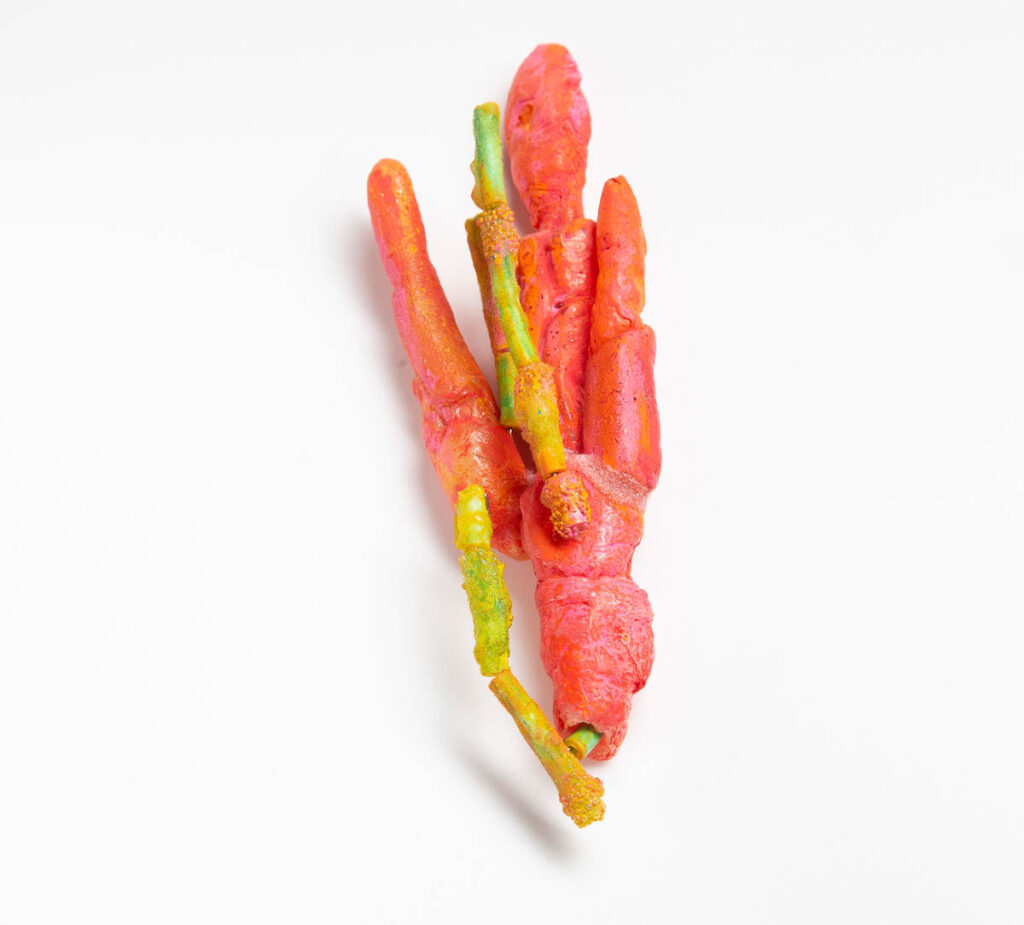
Kath Inglis, Codium + Coraline Epiphytes Brooch, 2021, 145mm x 55mm x 30mm, Cling wrap, ink, lollypop sticks, microbeads, epoxy resin, flocking + stainless steel wire, Photographer: Craig Arnold
Kath Inglis Entanglements is at Bilk Gallery from 10 November 2022.
About Kath Inglis
 Kath Inglis is an established contemporary jeweller working from a studio at the Hahndorf Academy in the Adelaide Hills and is the JamFactory’s Jewellery and Metal Studio Head. Raised in the cultural melting pot of Darwin, Kath Inglis moved to Adelaide to study contemporary jewellery. After graduating from the South Australian School of Art in 2000, Inglis continued to develop her practice by working from a number of studios, including the renowned Gray Street Workshop, JamFactory Metal Design Studio and soda and rhyme, a studio and gallery established in partnership with Naomi Schwartz. Inglis has developed a distinctive range of jewellery by working with her signature material, polyvinyl chloride (PVC). The material is sourced as a clear flexible sheet and is manipulated by a process of colouring, cutting, carving and more recently, heat-fusing layers. The relationship between the material, maker and tool is significant to Inglis’s practice. This approach continues to push the material in creative ways and forms a self-portrait of observations, concerns and issues. Follow @kath_inglis and visit www.kathinglis.com.
Kath Inglis is an established contemporary jeweller working from a studio at the Hahndorf Academy in the Adelaide Hills and is the JamFactory’s Jewellery and Metal Studio Head. Raised in the cultural melting pot of Darwin, Kath Inglis moved to Adelaide to study contemporary jewellery. After graduating from the South Australian School of Art in 2000, Inglis continued to develop her practice by working from a number of studios, including the renowned Gray Street Workshop, JamFactory Metal Design Studio and soda and rhyme, a studio and gallery established in partnership with Naomi Schwartz. Inglis has developed a distinctive range of jewellery by working with her signature material, polyvinyl chloride (PVC). The material is sourced as a clear flexible sheet and is manipulated by a process of colouring, cutting, carving and more recently, heat-fusing layers. The relationship between the material, maker and tool is significant to Inglis’s practice. This approach continues to push the material in creative ways and forms a self-portrait of observations, concerns and issues. Follow @kath_inglis and visit www.kathinglis.com.

